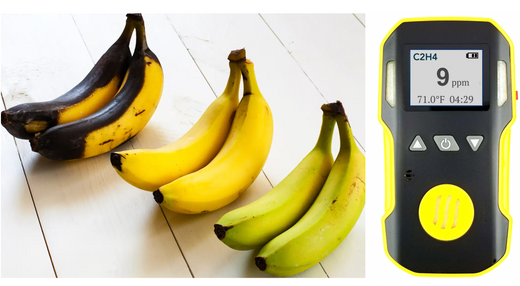In the commercial fresh produce industry, ethylene gas is used to artificially ripen fruits and vegetables to meet buyer demands. Ethylene gas detectors play a crucial role in ensuring that the optimal ethylene concentration is introduced for each type of produce, as different products require specific levels and exposure times for ideal ripening. Ethylene gas detectors are essential tools in this process, continuously monitoring the atmosphere to maintain the desired ethylene levels. These detectors provide real-time data, enabling produce companies to adjust ethylene concentrations as needed. By implementing accurate ethylene gas detection, fresh produce businesses can ensure consistent ripening results, minimize product waste, and deliver high-quality fruits and vegetables to their customers.
Pros |
Cons |
|
✅ Ethylene is a hormone with the capability to ripen produce. ✅ The use of an ethylene gas detector enables the correct amount of ethylene to be added to produce to ripen them quickly without over-ripening them. |
⛔ Ethylene gas detectors are a unique product that are not cheap. ⛔ Ethylene gas detectors require periodic calibration and have a limited 2 to 3 year lifetime. ⛔ Some ethylene gas detectors are expensive, but most can be purchase for less than $500. |
What is the Best Ethylene Gas Detector?
There are a number of excellent ethylene gas detectors available on the market today. Top options include:
- Forensics Detectors Ethylene C2H4 Gas Detector
- Crowcon Ethylene Single-Gas Monitor
- Honeywell Ethylene Optima Plus
- Macurco Ex Series Gas Detector for Ethylene
Where Are Ethylene Gas Detectors Placed?
Ethylene as gas is lighter than air. Due to this, ethylene gas tends to rise. However, it is best to mount units at the point of interest, either as close to the fruit as possible or at the breathing location of humans. Handheld devices may be clipped to the user or simply held in the hand when they are in use.

What is a Ethylene Leak Detector?
Since ethylene is injected into ripening rooms, some of the gas may leak into areas that may expose humans to toxic ethylene gas. It is good practice to regularly check the seals, seams and connections of ripening rooms to make sure ethylene gas is not escaping. Ethylene leak detectors are used to check for ethylene gas leak around the perimeter of ripening rooms.
What is Ethylene Gas?
Britannica notes that ethylene is a colorless and flammable gas that has a distinctly sweet odor to it. Additionally, the taste is also described as sweet. It is naturally occurring in natural gas, petroleum, plants, and fruit.
 Is Ethylene Dangerous?
Is Ethylene Dangerous?
Ethylene gas is associated with some dangers.
The AGCIH has a 8 hr Time Weighted Avg (TWA): 200 ppm. It also notes that Transient increases in workers' exposure levels may exceed 3 times the value of the TLV-TWA level for no more than 15 minutes at a time, on no more than 4 occasions spaced 1 hour apart during a workday, and under no circumstances should they exceed 5 times the value of the TLV-TWA level. In addition, the 8-hour TWA is not to be exceeded for an 8-hour work period.
It can affect people in the following ways:
- Breathing may cause irritation
- Skin-to-skin contact may cause frostbite
- Headache
- Dizziness
- Fatigue
- Lightheadedness
- Unconsciousness
- Confusion
Furthermore, ethylene is flammable and reactive, meaning it could potentially cause a fire or explosion. The Explosion limit of ethylene is vol% in air: 2.7-36.0.
How is Ethylene Produced?
High-pressure gas cylinders or ethylene generators are two common ways to add ethylene to the ripening rooms. If ethylene is delivered into rooms via pipes from cylinders, there are opportunities for leaks, and the risk of explosion from pure ethylene cylinders is high. The use of an ethylene gas detector to continuously monitor the ethylene gas levels in the cylinder storage room is highly recommended.

What is a Ripening Room?
It is a room where produce ripens. Ethylene is injected in these rooms to assist with the ripening process.
Ripening rooms are typically regulated environments in which fruit and vegetables are exposed to controlled humidity (80-90 percent), temperature (80-90 degrees Fahrenheit), and a continuous concentration of Ethylene (normally 150-200 parts per million), depending on the fruit to be ripened.
What Effect Does Ethylene Have on Fruit?
Ethylene contributes to ripening. It is a plant hormone that is produced in larger quantities when the fruit is preparing to ripen.
How Does Fruit Ripening Work?
The basic cause of fruit ripening is the gaseous plant hormone, ethylene. Ethylene interacts with two plant genes, ETR1 and CTR1, that then activate and allow for fruit ripening. Plants can produce their own ethylene in addition to responding to ethylene encountered in their environment.

Is Fruit Ripening Dangerous?
Natural fruit ripening by ethylene is not dangerous to humans. However, artificial ripening that mimics that natural ripening process with ethylene, particularly when used at high concentration in confined spaces may pose a danger - hence monitoring and tracking ethylene gas concentration is a good idea.
Is Ethylene Necessary for Fruit Ripening?
Yes.
The plant hormone ethylene is critical to trigger fruit ripening. It both triggers and continues the process of fruit ripening until the fruit is fully ripe or, unfortunately, over-ripens.
How Do You Test for the Presence of Ethylene Gas?
Ethylene gas can be measured using an ethylene gas detector. Most devices will utilize a gas chromatograph, or similar sensory tool, to test for a sample of the hormone passing through a carrier gas. Most recently, lower cost electrochemical sensors have been used to detector ethylene which has dramatically reduced the price of ethylene gas detectors below $500.
What is an Ethylene Gas Detector?
An ethylene gas detector is a sensory device used to monitor the presence of ethylene gas in air. It can be useful in identifying whether there is enough ethylene in the air to promote fruit ripening and also to control exposure time for an optimal fruit ripening process.
How Do You Choose an Ethylene Gas Detector?
Ethylene gas detectors typically use one of three sensing technologies:
- Infrared gas detection: certain types of molecules have the capacity to absorb light at wavelengths corresponding to a given molecular structure. Infrared gas detection, or IR gas detection, takes advantage of this ability through dual-wavelength technology. IR detectors come in two different types: point and path. All IR detectors are associated with a number of benefits such as resistance to corrosion.
- Catalytic gas detection: catalytic combustion can be used to measure combustible gases, such as ethylene, through catalytic gas detectors. These devices use a catalyst to oxidize a given combustible gas of interest. The oxidization is observed by a sensor that converts the change in temperature to a change in electrical resistance that can then be recognized as a change in gas concentration by the user. These detectors are typically easy to both install and use.
- Ultrasonic gas leak detection: changes in background noise can allow an ultrasonic gas leak detector to detect a gas leak when gas is released. In simplest terms, it uses a microphone to monitor broadband sound released from a leak. It is a non-selective ethylene gas detector that also confers the benefit of instant detection of gas leaks, potentially those involving ethylene, from pressurized vessels.

Who Uses an Ethylene Gas Detector?
Most members of the general population will not need an ethylene gas detector. However, certain specialized occupations may benefit greatly from using an ethylene gas detector.
Commercial Fresh Produce Companies
In most cases, commercial fresh produce companies seek to meet demand by increasing the speed of the ripening process for their produce. This is often achieved by introducing greater quantities of ethylene to the produce. Too little ethylene will cause the produce to fail to ripen in the desired timeframe while too much ethylene may cause the produce to rot, emphasizing the importance of using an ethylene gas detector to monitor levels of ethylene.
Research Scientists
Scientists interested in ethylene and fruit ripening would certainly benefit from the use of an ethylene gas detector. Such a device gives these researchers the means to accurately analyze the presence of ethylene and thus yield more precise and useful data.

What is an Appropriate Ethylene Gas Level for a Banana?
The range for an appropriate ethylene gas level for a banana is between 100 and 150 ppm of ethylene. Appropriate ethylene gas levels may vary significantly depending on the type of produce that is of interest.
What is the Threshold Level of Ethylene in Fruits and Vegetables?
In plants, including fruits and vegetables, the threshold level of ethylene is typically considered to be 0.1 ppm. Too little ethylene can cause the fruit or vegetable to have difficulty ripening while too much ethylene may cause the fruit or vegetable to over-ripen and go bad.

Can I See or Smell Ethylene?
Some people can neither see nor smell ethylene. As such, it is invisible to these individuals. To others, ethylene may have a distinctly sweet smell, but remains colorless.
Are There Any Risks Associated With Smelling Ethylene In High Concentrations?
Yes, exposure to high concentrations of ethylene can cause dizziness, headaches, drowsiness, and asphyxiation. It can displace oxygen in confined spaces, leading to unconsciousness.
Final Words
Ethylene, a gaseous hormone naturally produced by fruits and vegetables, plays a crucial role in the ripening process. In the commercial fresh produce industry, ethylene gas detection is essential for ensuring that the optimal concentration is introduced to achieve desired ripening results while preventing overripening and rot. Ethylene detectors continuously monitor the atmosphere, providing real-time data to maintain the ideal ethylene levels for each type of produce. Although ethylene is a natural hormone, human exposure should not exceed 200ppm over an 8-hour period, as per ACGIH recommendations. By implementing accurate ethylene gas detection, produce companies can ensure consistent ripening, minimize waste, and protect workers from potential health risks associated with excessive ethylene exposure.
About the Author
Dr. Kos Galatsis ("Dr.Koz") is the President of FORENSICS DETECTORS, where the company operates from the scenic Palos Verdes Peninsula in Los Angeles, California. He is a subject matter expert on gas sensor technology, gas detectors, gas meters, and gas analyzers. He has been designing, building, manufacturing, and testing toxic gas detection systems for over 20 years.

Every day is a blessing for Dr. Koz. He loves to help customers solve their unique problems. Dr. Koz also loves spending time with his wife and his three children going to the beach, grilling burgers, and enjoying the outdoors.
Read more about Forensics Detectors here.
Email: drkoz@forensicsdetectors.com
Phone: +1 424-341-3886

